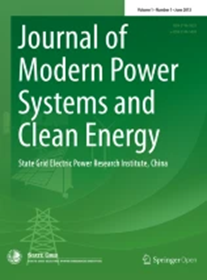风-热捆绑系统的阻尼特性分析
IF 5.7
1区 工程技术
Q1 ENGINEERING, ELECTRICAL & ELECTRONIC
Journal of Modern Power Systems and Clean Energy
Pub Date : 2024-03-10
DOI:10.35833/MPCE.2023.000639
引用次数: 0
摘要
风光热联合系统已成为最主要的电力系统类型,其中包含了相当比例的可再生能源。该系统的动态相互作用机理复杂,振荡稳定性问题突出。本文采用路径分析方法(PAM)分析了直流电容振荡模式的阻尼特性。该方法结合了传递函数框图和阻尼力矩分析法(DTA)。首先,根据传递函数建立永磁同步发电机 (PMSG)、同步发电机 (SG) 和交流电网的线性模型。得出了风热联合系统的闭环传递函数框图。其次,框图揭示了系统的阻尼路径和动态交互机制。根据叠加原理,重构传递函数框图,实现阻尼分离。利用 DTA 的阻尼系数来量化子系统之间的相互作用对振荡模式阻尼特性的影响。然后,利用特征值分析来分析系统稳定性。最后,通过时域模拟对阻尼特性分析进行验证。本文章由计算机程序翻译,如有差异,请以英文原文为准。
Damping Characteristic Analysis of Wind-Thermal-Bundled Systems
Wind-thermal-bundled system has emerged as the predominant type of power system, incorporating a significant proportion of renewable energy. The dynamic interaction mechanism of the system is complex, and the issue of oscillation stability is significant. In this paper, the damping characteristics of the direct current (DC) capacitance oscillation mode are analyzed using the path analysis method (PAM). This method combines the transfer-function block diagram with the damping torque analysis (DTA). Firstly, the linear models of the permanent magnet synchronous generator (PMSG), the synchronous generator (SG), and the alternating current (AC) grid are established based on the transfer functions. The closed-loop transfer-function block diagram of the wind-thermal-bundled systems is derived. Secondly, the block diagram reveals the damping path and the dynamic interaction mechanism of the system. According to the superposition principle, the transfer-function block diagram is reconstructed to achieve the damping separation. The damping coefficient of the DTA is used to quantify the effect of the interaction between the subsystems on the damping characteristics of the oscillation mode. Then, the eigenvalue analysis is used to analyze the system stability. Finally, the damping characteristic analysis is validated by time-domain simulations.
求助全文
通过发布文献求助,成功后即可免费获取论文全文。
去求助
来源期刊

Journal of Modern Power Systems and Clean Energy
ENGINEERING, ELECTRICAL & ELECTRONIC-
CiteScore
12.30
自引率
14.30%
发文量
97
审稿时长
13 weeks
期刊介绍:
Journal of Modern Power Systems and Clean Energy (MPCE), commencing from June, 2013, is a newly established, peer-reviewed and quarterly published journal in English. It is the first international power engineering journal originated in mainland China. MPCE publishes original papers, short letters and review articles in the field of modern power systems with focus on smart grid technology and renewable energy integration, etc.
 求助内容:
求助内容: 应助结果提醒方式:
应助结果提醒方式:


